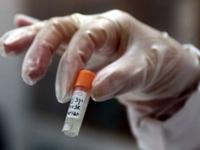-
Disagreement over use of experimental drugs in desperate effort to contain Ebola outbreak
The efforts to contain the largest Ebola outbreak in history have so far failed. International response teams, desperate to limit the toll of the fast-spreading epidemic in three West African countries, have been calling for the use experimental drugs or vaccines to try to stop the deadly virus. Many experts, however, including the scientist who led the work on a Canadian-made Ebola vaccine, say that using untested medications in the current West African outbreak could be disastrous. Other scientists disagree. The World Health Organization reports that the current outbreak, which is the first in West Africa, has so far infected 844 people, causing the death of 518 of them. This is double the size of the next largest outbreak, in Uganda in 2000, and this outbreak has just begun.
-
-
Smallpox vials found unguarded at NIH campus in Bethesda, Md.

Earlier this month workers clearing out a Food and Drug Administration(FDA) branch office at the National Institutes of Health(NIH) campus in Bethesda, Maryland, discovered vials containing smallpox, an eradicated agent feared for its bioweapons potential. The last smallpox samples in existence were thought to be held at tightly guarded facilities in Atlanta and the State Research Center of Virology and Biotechnologyin Novosibirsk, Russia. The vials appear to date from the 1950s.
-
-
Convergence of chemistry and biology raises concerns about designer toxins
The convergence of chemistry and biology is providing major benefits to humankind, particularly in health care, alternative energy sources, and in environmental control – and when combined with other advances, particularly in nanotechnology, it is also being exploited in developing improved defensive countermeasures against chemical and biological warfare agents. This convergence, however, has also raised concerns that biotechnology could be applied to the production of new toxic chemicals, bioregulators, and toxins. A new report from OPCW says that the potential for scaling up biological processes for large scale production of chemicals of concern is still limited, but biomediated processes might still be effective for producing weaponizable quantities of toxins which are lethal to humans in microgram or lower dosage.
-
-
CDC says anthrax infection “highly unlikely,” but reassigns bioterror lab chief
The U.S. Centers for Disease Control and Prevention(CDC) has advised some of its employees to stop taking antibiotics meant to fight a possible anthrax infection after preliminary tests suggest that it is “highly unlikely” those employees were exposed to live anthrax following an incident in June. Michael Farrell, head of the CDC bioterror lab, has been reassigned.
-
-
John Tull, whose 2002 bubonic plague illness raised bioterrorism fears, dies
In November 2002, John Tull, a New Mexico lawyer, was visiting New York when he was found to have bubonic plague. The discovery occurred a year after the fall 2001 anthrax attacks – which, at the time, were still unresolved – raising fears that Tull was a victim of bioterrorism. Those concerns were alleviated when it was determined that Tull’s case was linked to fleas in northern New Mexico, where Tull and his wife had a five-acre property outside Santa Fe. Tull, 65, died last week of cancer not related to the 2002 illness.
-
-
Foreign investment in agriculture increases productivity of subsistence farming
The improved infrastructure brought about by foreign investment could increase the productivity of subsistence farmlands in countries such as Indonesia and Papua New Guinea and could mean these lands can feed at least 300 million people around the world. This is compared to about 190 million people that could be fed if the land was left tended to by the local population. The most targeted countries for land grabs are Indonesia, Malaysia, Papua New Guinea, and the former Sudan. Altogether, these nations account for around 82 percent of the total food calories that can be produced by acquired croplands worldwide.
-
-
Congress debates BioShield funding while medical schools debate bioterrorism training
Just as researchers urge medical schools across the United States to include bioterrorism preparedness courses in their curricula, Congress is debating whether to continue spending on Project Bioshield, an initiative launched in 2004 to incentivize otherwise unprofitable research on treatments for rare outbreaks or bioterror agents such as anthrax and botulinum toxin.
-
-
WIPP radiation leak investigation focuses on Los Alamos National Laboratory (LANL)
The U.S. Department of Energy’s (DOE) accident investigation team reviewing the leak at the Waste Isolation Pilot Plant (WIPP) in Carlsbad, New Mexico has turned its focus to the Los Alamos National Laboratory (LANL). Communications between LANL and EnergySolutions, the contractor which packaged LANL’s waste for shipment to WIPP, have revealed that EnergySolutions switched from using an inorganic clay-based absorbent in the storage drums to an organic wheat-based mixture. Scientists are now trying to determine whether the switch to the organic substance is to blame for the chemical reaction that led to the explosion.
-
-
Better tools for tracing food-borne illness to source
Research could make it easier for public health investigators to determine if a case of food poisoning is an isolated incident or part of a larger outbreak. The study focuses on a test called multi-locus variable number tandem repeats variable analysis (MLVA). The test, which is increasingly used in the detection and investigation of foodborne outbreaks, analyzes specific sequences of DNA (called loci) that change rapidly enough over time to distinguish outbreak strains from other circulating strains of the bacteria but not so rapidly that connections could be masked by changes arising during the course of an outbreak.
-
-
Congress may modify the amount, manner by which Project BioShield procurements are funded
In 2004, Congress passed the Project BioShield Act to provide the federal government with new authorities related to the development, procurement, and use of medical countermeasures against chemical, biological, radiological, and nuclear (CBRN) terrorism agents. Among other things, the authority allows the government to guarantee a market for CBRN medical countermeasures. Under this provision, the secretary of Health and Human Services (HHS) may obligate funds to purchase countermeasures that still need up to ten more years of development. Since 2004, HHS has obligated approximately $3.309 billion to guarantee a government market for countermeasures against anthrax, smallpox, botulism, radiation, and nerve agents. Another provision established a process through which the HHS secretary may temporarily allow the emergency use of countermeasures which lack Food and Drug Administration (FDA) approval. The 113th Congress may also consider modifying the amount and manner by which it funds Project BioShield procurements.
-
-
Canadian dirt containing Kryptonite for superbugs
A fungus living in the soils of Nova Scotia could offer new hope in the pressing battle against drug-resistant germs that kill tens of thousands of people every year, including one considered a serious global threat. A team of researchers has discovered a fungus-derived molecule, known as AMA, which is able to disarm one of the most dangerous antibiotic-resistance genes: NDM-1 or New Delhi Metallo-beta-Lactamase-1, identified by the World Health Organization as a global public health threat.
-
-
Groundwater could be polluted with heavy metals by fracking flowback
The chemical makeup of wastewater generated by “hydrofracking” could cause the release of tiny particles in soils that often strongly bind heavy metals and pollutants, exacerbating the environmental risks during accidental spills, Cornell University researchers have found. Previous research has shown 10 to 40 percent of the water and chemical solution mixture injected at high pressure into deep rock strata, surges back to the surface during well development. Researchers found that the same properties that make the mixture so effective at extracting natural gas from shale can also displace tiny particles that are naturally bound to soil, causing associated pollutants such as heavy metals to leach out.
-
-
Ebola epidemic in West Africa is “out of control”
Médecins Sans Frontières (MSF) has warned that the ebola epidemic in west Africa is “out of control” and will not be contained unless politicians, religious leaders, and aid agencies urgently improve their response to the unprecedented outbreak. The deadly disease is continuing to spread through Guinea, Sierra Leone, and Liberia, and the World Health Organization (WHO) says the outbreak has so far claimed 337 lives. WHO says that the confirmed, probable, or suspected cases stands at 528, with the disease identified in more than sixty locations across the three west African countries. The WHO said on Saturday that a failure by the authorities in Guinea to gauge the severity of the initial outbreak, and a subsequent relaxation of counter-measures, had created a “second wave” of the disease.
-
-
The “militarization of health care” threatening the health of local populations: experts
The surge in murders of polio vaccination workers in Pakistan has made headlines this year, but little attention has been devoted to the ethical issues surrounding the global health impact of current counterterrorism policy and practice. A new study traces the ways that the war on terror is incorporating medicine into warfare – what the researchers call “the militarization of health care” — threatening the health of local populations, increasing global health disparities, and causing profound moral distress among humanitarian and health care workers.
-
-
Forensic geographical profiling technique targets killer diseases

A mathematical tool used by the Metropolitan Police and FBI has been adapted by researchers to help control outbreaks of malaria, and has the potential to target other infectious diseases. The researchers have shown how the math that underpins what law enforcement calls “geographic profiling” can be adapted to target the control of infectious diseases, including malaria.
-
More headlines
The long view
Ransomware Attacks: Death Threats, Endangered Patients and Millions of Dollars in Damages
A ransomware attack on Change Healthcare, a company that processes 15 billion health care transactions annually and deals with 1 in 3 patient records in the United States, is continuing to cause massive disruptions nearly three weeks later. The incident, which started on February 21, has been called the “most significant cyberattack on the U.S. health care system” by the American Hospital Association. It is just the latest example of an increasing trend.
